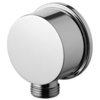Hi all.
I'm tarting up a shower room and fixing an ideal standard shower hose elbow, but I'm a but concerned about fitting it.
It has a brass threaded tube sticking out the back and I'm going to set a wall plate elbow into the wall to screw it into. I wont be able to screw it fully into the wall elbow because it has a soft rubber washer that seals against the tiles. Obviously I want it to end up with the outlet for the shower hose pointing down, so that will decide how far it goes into the wall elbow. I'm worried it will leak in the wall. I won't know it's leaking either as I won't be able to see once it's tightened up to the tiles.
I've got Loctite 55, or ptfe tape, or could get a liquid thread seal if that's a better choice. But how sure can I be that it will seal when I can't see inside the wall.
Thanks.
I'm tarting up a shower room and fixing an ideal standard shower hose elbow, but I'm a but concerned about fitting it.
It has a brass threaded tube sticking out the back and I'm going to set a wall plate elbow into the wall to screw it into. I wont be able to screw it fully into the wall elbow because it has a soft rubber washer that seals against the tiles. Obviously I want it to end up with the outlet for the shower hose pointing down, so that will decide how far it goes into the wall elbow. I'm worried it will leak in the wall. I won't know it's leaking either as I won't be able to see once it's tightened up to the tiles.
I've got Loctite 55, or ptfe tape, or could get a liquid thread seal if that's a better choice. But how sure can I be that it will seal when I can't see inside the wall.
Thanks.


